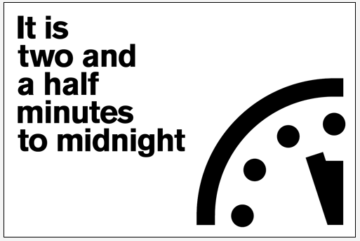Ian Lowe in Kurzweil AI:
 It made headlines recently when the Doomsday Clock was shifted on January 26, 2017 from three minutes to midnight to a new setting of two and a half minutes to midnight.* That is the nearest the clock has been to midnight for more than 50 years. The body responsible for the clock said the probability of global catastrophe is very high, and the actions needed to reduce the risks of disaster must be taken very soon. It should be an urgent warning to world leaders. The idea of a Doomsday Clock was conceived by the editorial staff of the Bulletin of the Atomic Scientists, which was founded by many of the scientists who worked on the Manhattan Project.
It made headlines recently when the Doomsday Clock was shifted on January 26, 2017 from three minutes to midnight to a new setting of two and a half minutes to midnight.* That is the nearest the clock has been to midnight for more than 50 years. The body responsible for the clock said the probability of global catastrophe is very high, and the actions needed to reduce the risks of disaster must be taken very soon. It should be an urgent warning to world leaders. The idea of a Doomsday Clock was conceived by the editorial staff of the Bulletin of the Atomic Scientists, which was founded by many of the scientists who worked on the Manhattan Project.
When that publication graduated from being an internal newsletter among the nuclear science community to being a formal magazine in 1947, the clock appeared on the cover. The magazine’s founders said the clock symbolised the urgency of the nuclear dangers that we — and the broader scientific community — are trying to convey to the public and political leaders around the world.
The clock was [initially] set at seven minutes to midnight. Two years later, with the news that a nuclear weapon had been tested by the USSR, the communist state centered on modern Russia, the clock was moved to 11.57. In 1953, the USA first tested the hydrogen bomb, a fusion weapon much more powerful than the fission bombs that had destroyed Hiroshima and Nagasaki. The USSR followed a few months later and the clock was advanced to 11.58 with a warning there was a real chance that from Moscow to Chicago, atomic explosions will strike midnight for Western civilization.
Then there was a period of modest progress. It gradually became apparent that the new weapons were so powerful that only a deranged leader would consider using them against a similarly armed enemy, given the inevitability of catastrophic retaliation. In 1963, after they had been continuously testing more and more deadly weapons, the USA and the USSR signed the Partial Test Ban Treaty, which prohibited atmospheric testing. The clock was moved back to 11.48.
It was a false dawn.
More here.
